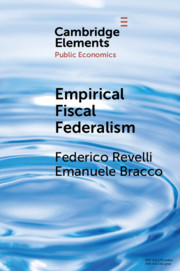Element contents
Empirical Fiscal Federalism
Published online by Cambridge University Press: 29 October 2020
Summary
- Type
- Element
- Information
- Series: Elements in Public EconomicsOnline ISBN: 9781108918039Publisher: Cambridge University PressPrint publication: 04 February 2021
References
- 9
- Cited by



